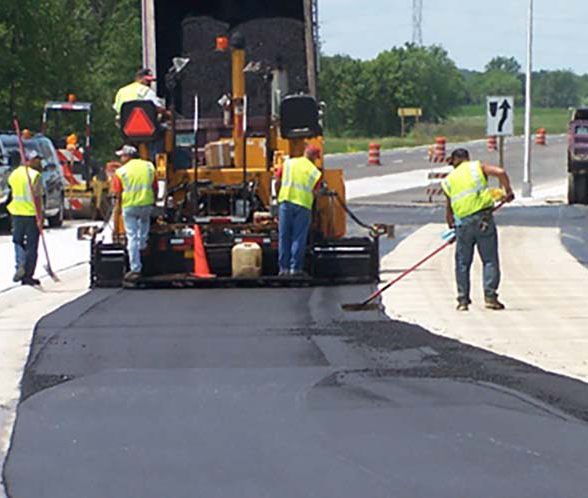Hot Mix Asphalt Paving: Redefining Commercial Building Landscapes
Hot Mix Asphalt Paving: Redefining Commercial Building Landscapes
Blog Article
Opening the Secrets of Hot Mix Asphalt Modern Technology
Exploring the midsts of warm mix asphalt innovation reveals a world where meticulous procedures and specific solutions merge to shape our roads and infrastructure. The blend of fillers, binders, and accumulations isn't merely a construction task however a strategic orchestration of toughness and efficiency. As we peer into the complex dancing of elements, a tapestry of resilience and sustainability unravels. What exists underneath this surface of asphaltic mastery, and what secrets wait to be revealed in the world of leading developments?
Value of Warm Mix Asphalt
Hot Mix Asphalt plays a vital role in modern infrastructure growth because of its toughness and cost-effectiveness. As the most generally utilized leading product for roadways, highways, and car parking great deals, Warm Mix Asphalt uses a variety of benefits that add to its value in building projects. One key advantage is its ability to stand up to rush hour tons and severe climate condition, supplying a lasting and reputable surface for transportation networks. In Addition, Hot Mix Asphalt is cost-effective in both first construction and lasting upkeep, making it a favored choice for several infrastructure tasks.
The longevity of Hot Mix Asphalt stems from its composition, which consists of aggregates, binder, and filler products that are thoroughly selected and blended to meet certain performance needs. Generally, the significance of Warm Mix Asphalt in facilities growth can not be downplayed, as it proceeds to be a foundation of contemporary building and construction techniques.
Parts of Asphalt Mixes
The structure of asphalt blends is composed of carefully chosen aggregates, binder, and filler products that are critical for achieving particular performance demands. Accumulations are the key part of asphalt blends, providing strength and stability. The binder, usually bitumen or asphalt cement, holds the aggregates together and supplies versatility and longevity to the mix.
The mix and percentage of these parts play a significant role in determining the quality and performance of the asphalt mix. Engineers carefully design the mix to meet specific requirements, considering elements like web traffic volume, climate conditions, and sidewalk lifespan. Proper selection and harmonizing of accumulations, binder, and fillers are necessary for developing long lasting, resilient asphalt pavements.
Mixing and Manufacturing Strategies

As soon as the accumulations are picked, the binder, often asphalt cement, is included in bind the materials with each other. The binder's top quality and amount significantly impact the mix's flexibility, strength, and resistance to environmental elements. Additionally, fillers like hydrated lime or Rose city concrete might Homepage be included to enhance details attributes of the asphalt mix, such as its workability or wetness resistance.
Throughout manufacturing, the accumulations and binder are warmed, commonly between 250-325 ° F(121-163 ° C ), to help with mixing and guarantee proper finishing of the accumulations. The blending process has to be comprehensive to achieve an uniform blend that promotes the preferred performance features of the asphalt. Different techniques, such as set blending or drum blending, are employed to achieve regular and top quality asphalt blends for building and construction jobs.
Factors Affecting Asphalt Efficiency
Aspects affecting asphalt performance include a variety of variables that influence the resilience, durability, and total quality of asphalt pavements. One essential aspect is the top quality of products used in the asphalt mix.
Design considerations, such as pavement thickness and drain, are vital in making sure the lasting efficiency of the asphalt sidewalk. By meticulously taking into consideration these professionals, elements and engineers can enhance asphalt efficiency and improve the continue reading this solution life of sidewalks.
Lasting Practices in Asphalt Technology

WMA permits for the production and positioning of asphalt blends at lower temperature levels contrasted to conventional hot-mix asphalt, resulting in minimized power consumption and greenhouse gas exhausts. The usage of porous asphalt mixes can aid mitigate stormwater overflow concerns by allowing water to infiltrate with the sidewalk and into the ground, promoting natural water purification and reenergize processes.
Final Thought
Finally, warm mix asphalt technology plays an essential function in contemporary facilities advancement because of its longevity and cost-effectiveness. By carefully balancing components, employing proper mixing techniques, and considering various factors, designers can develop high-quality asphalt blends that withstand hefty website traffic lots and rough climate problems. Accepting sustainable practices, such as making use of recycled products and warm-mix innovations, further boosts the ecological friendliness of asphalt technology.
Blending and production strategies in warm mix asphalt modern technology entail the accurate mix and handling of aggregates, binder, and fillers to develop a high-performance and durable asphalt mix.Elements influencing asphalt efficiency include a range of variables that influence the toughness, durability, and overall high quality of asphalt pavements. Lasting practices in asphalt modern technology include various efforts aimed at minimizing the environmental influence of asphalt production and paving procedures. By integrating reclaimed asphalt sidewalk (RAP) and recycled asphalt shingles (RAS) right into brand-new asphalt mixes, the sector can substantially reduce the usage of raw materials this hyperlink and energy, while additionally decreasing land fill waste.
WMA allows for the manufacturing and positioning of asphalt mixes at reduced temperatures compared to typical hot-mix asphalt, resulting in decreased power consumption and greenhouse gas discharges.
Report this page